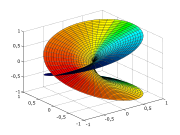| Kalkülüs |
|---|
 |
| |
| |
İntegral İntegral Alma Yöntemleri:
- Kısmi İntegrasyon
- değişken değiştirme
|
| |
| |
|
Türev, matematikteki ve özellikle diferansiyeldeki temel kavramlardan biridir. Aşağıda bazı fonksiyonların türev kuralları yer almaktadır. Burada, f ve g türevlenebilir fonksiyonlar ve c ise reel sayıdır.
Genel fonksiyonların imge kuralları
- Genel kurallar

İki Fonksiyonun Çarpımının Türevi
[f(x)*g(x)]’=[f'(x)*g(x)]+[f(x)*g'(x)] şeklinde olmalıdır.[1]
d/dx, fonksiyonun x'e göre türevinin alındığını gösterir.





Trigonometrik fonksiyonların türevi, temel prensipler kullanılarak, yani eğrinin eğimini veren cebirsel bir ifade bulunarak elde edilir:[2]

























Zincir kuralı, iki ve ikiden fazla türevlenebilir fonksiyonların bileşkesinin türevini almak için kullanılır.  tane fonksiyonunun bileşkesinin türevini almak için:
tane fonksiyonunun bileşkesinin türevini almak için:  şeklindedir. Yani en dıştan içe doğru fonksiyonların türevi alınarak içindeki fonksiyonların bileşkesi alınır ve çarpılır. Örneğin
şeklindedir. Yani en dıştan içe doğru fonksiyonların türevi alınarak içindeki fonksiyonların bileşkesi alınır ve çarpılır. Örneğin  fonksiyonunun türevini alalım.
fonksiyonunun türevini alalım. 


Logaritma ile türev alma
Logaritma ile türev alma özellikle karmaşık fonksiyonlar için kullanılır. Logaritma ile türev alınırken ilk önce fonksiyon yazılır ve fonksiyonun doğal logaritması alınır. Sonra da iki tarafında türevi alınır. Son olarakta fonksiyonun türevi izole edilir. Örnek olarak  fonksiyonunun logaritma ile türevini alalım:
fonksiyonunun logaritma ile türevini alalım: 




gördüğünüz gibi türevin çarpma kuralını elde etmiş olduk.
Kaynakça
- ^ "Türev Alma Kuralları ve Türev Örnek Soru Çözümü". www.ogretmentercihim.com. 16 Nisan 2021 tarihinde kaynağından arşivlendi. Erişim tarihi: 6 Nisan 2021.
- ^ Bourne, Murray. "1. Derivatives of Sine, Cosine and Tangent". www.intmath.com (İngilizce). 17 Şubat 2020 tarihinde kaynağından arşivlendi. Erişim tarihi: 17 Şubat 2020.



















































